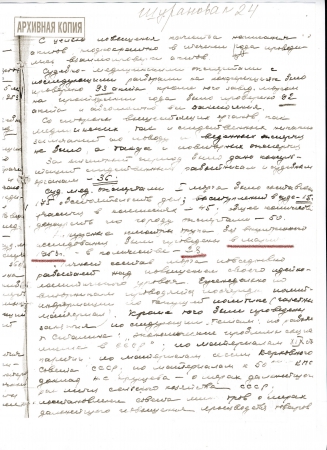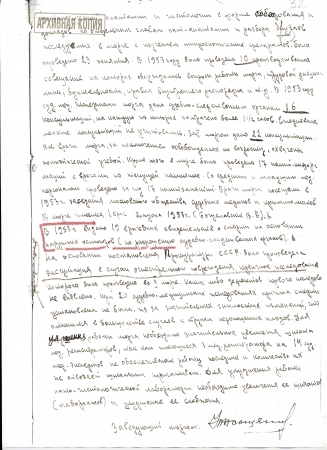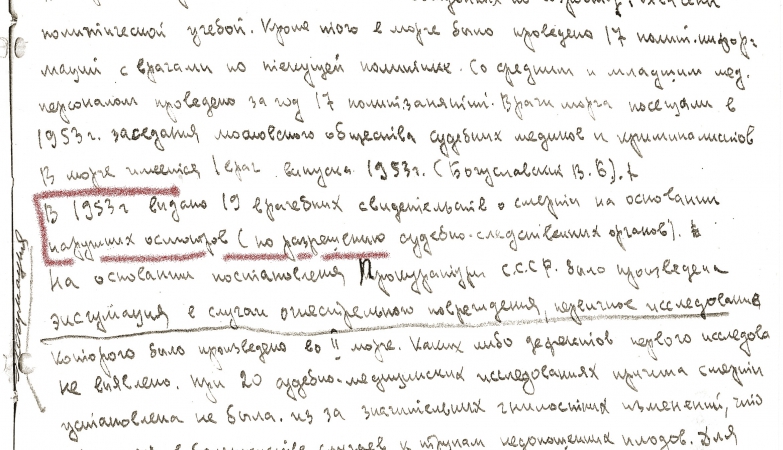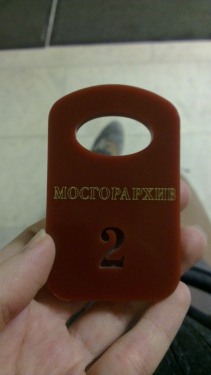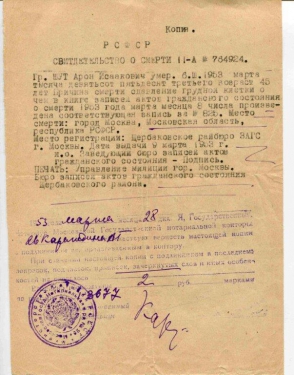Personal experience: 5th of March 1953
Sixty years after the death of Stalin eyewitnesses of the events of the 5–9 of March 1953 told about what traces these days left in their memories. The project 05/03/53 is still today publishing interviews, many of which bear testimony of what happened during the day of paying their last respects to the leader, about the stampede, and about the massive number of people who died. You can’t find the names of the deceased ones in the lists of victims of political repressions – to count them to the millions of people who suffered from the despotism of the totalitarian regime would be to say the least, strange. Anyhow, the people who died in the stampede on the 6th of March don’t have anything in common with those who the Rehabilitation Act concerns, and therefor this law doesn’t apply to them. The hushing about the number and names of the injured persons is a typical characteristic of the attitude of the government towards the destiny of these people and their relatives.The tragedy of the 6th of March was mentioned officially only once, more precisely when N. S. Khrushchev during an appearance on a friendly dinner in Varna (Bulgaria) on the 16th of May 1962 said: ”You know, comrades, when Stalin died, there was a real stampede, because of all the people who wanted to see him one last time. 109 people were suffocated, the crowd smothered them. The police was powerless.” After a few months of archival research I can say for sure that that number isn’t correct. For one thing, since according to the morgues in Moscow (and this is far from all the places where it is worth looking), there were at least 60 more victims.
I tried out different strategies of searching for information about the deceased ones: in archives of registration offices (which, as it turned out, aren’t obligated to provide materials to anybody, except for state organs), in archival documents of the Moscow City Committee (where it possibly lies notes in the name of Khrushchev somewhere), but the first real results I got when going through medical statistics from 1953. A personal matter for everyone is now publishing extracts from my archival findings.
22nd of April
– To what extent are archival funds from the Public Healthcare of the City of Moscow presented in Your archive? I am interested in, for example, statistics on the number of callouts for ambulances on the 6th of March 1953.
– We don’t have any information concerning the Public Healthcare of the City of Moscow. Please turn to the archive of the Department of Public Healthcare.
I hurried to follow the advice I had gotten, but at the Central Archive of the Department of Public Healthcare they answered the same question in the following way: ”We don’t have any statistics. Please call the Bureau of Medical Statistics”. But at the bureau, after having clarified that all composite medical records concerning Moscow in 1953 should be in fund № 551, I was advised call to the storage of the main archive. This time I was a bit luckier: the supervisor of the storage confirmed that the fund I need contains all statistical material from 1933, and also invited me to visit the reading hall of the main archive. In that way, I was back at square one.
25th of April
Place of destination: reading hall № 1 of the Main Archive of the Administration of Moscow on Profsoyuznaya street 80.
The guard: ”There is a telephone behind you. Call number 269 – they will make an access card for you”.
I’m calling: ”I have come to the reading hall for the first time, I need an access card”. The woman who came to the entrance asked for my passport. She rewrote my surname, first name and patronymic, the number and series of the passport, and gave me a piece of paper, ”A temporary access card”. This card I then had to give to the guard, who in his turn provided me with a log sheet and a key to a safety deposit box in the cloakroom. It turned out that it’s forbidden to bring bags and nontransparent packages into the reading hall. It was necessary to go through a barter and unloading of things every time when entering and leaving the archive.
I am waiting for my turn to register at the small window with the sign Central Archive of the City of Moscow (after a month they exchanged it for the right one: Center for Preservation of Documents after 1917). A young man standing in front of me, and I observe the discussion when an employee of the archive is trying to find out the intention his visit to the archive.
– You see, I have a personal interest! I don’t want to define it more precisely than that.
– You can’t write that on the form. It doesn’t go like that.
– But it’s a personal matter! Questions of legal succession.
– You have to fill out something in the field ”Aim of research” of the form and the application…
The debate continues until the young man accused the employee of the archive of tactlessness and rudeness. Then the woman all of a sudden softened and explained to her collocutor how he better fill out the form.
To avoid such misunderstandings I was already prepared with an official letter from my organization. ”Please fill out the form and get acquainted with the regulations of using the reading hall. Taking pictures in there is forbidden. Lists of contents are delivered the day after they were ordered. In one day you can order a maximum of ten files and five lists of contents” the employee of the Center for Preservation of Documents told me and gave me a folder with the regulations of working with archival documents (you can find a similar version of the regulations on their site). At the end of the procedure of the registration I was told how to fill out the form ”Order (request) for copies of archival files, funds and lists of contents of archival files”, and noted that it’s not possible to hand in a request for archival files later than one hour before the reading hall closes for the day. The same day I made my first order – for the list of contents of fund № 551.
29th of April
I got the list of contents of fund № 551 (1933-1960) that I had ordered. 1068 files are included. The files are organized year-wise. It took me the whole day to look through the list of contents. I ordered seven files, and they told me I could come back on the 7th of May.
7th of May
The user can’t do any new orders if he in the same time doesn’t hand in all of the documents he had ordered before. This slows down the work a lot. Today for example, when I was working in the archive, I wanted to order two lists of contents to look through the next time. But I also had seven files in my hands. I had already looked though four of them, that wouldn’t come in useful the next time. (But to hand in only those files is also impossible! I get all of the seven files back!) So, in a week I will come back to look through the remaining three files. And only then it will be possible to hand in all of the seven files and make a new order, that will be delivered to me either on the next day or in a few days. The files are stored in the reading hall for one month after the order was made.
10th of June
I ordered the lists of contents of the funds № 551 and № 656 (The Moscow City Research Institute of Emergency Care N.V. Sklifosovsky).
11th of June
I looked through 14 files: nothing.
18th of June
I found something interesting in file № 78 (List of contents №656, Orders of the director of the Institute of Core Activities in 1953). Among the orders on core activities of the Moscow City Research Institute of Emergency Care N.V. Sklifosovsky I encountered the following order from the 9th of March:
”For analyzing and forming a list of the belongings of the persons who were taken to the anatomic pathology department on the 6th of March a commission of the following persons should be formed: the head nurse of the institute, a doctor, a representative of the Moscow criminal investigation”.
I was given file № 86, whose name doesn't match with what I ordered according to the list of contents № 656. Instead of annual statistical reports from 1953 to 1957 I got a ”Report of scientific and methodical work in 1956”. They can’t help me in any way.
24th of June
A finding! In file № 54 (”Annual reports on the work of branches of the bureau in 1953”) of fund № 559 (”State Department of Public Healthcare of the City of Moscow. The Bureau of Forensic Medical Examination of the Department of Public Healthcare of the City of Moscow”) there was an ”Explanatory letter of the annual report on the work in the morgue of the institute N.V. Sklifosovsky in 1953”. According to this note, from the 5th to the 7th of March (B. Kolkhoznaya square 3) 122 corpses were submitted to the morgue, that ”by the order of the executive board” (the heads of the City Health Department and the administration of the Police Department) were only ”superficially examined, with a description of the clothes”. An identification of the deceased ones was also conducted. This number is exclusively mentioned again in the yearly report on the work of the morgue – it was in other words a unique case in that year.
28th of June
In the ”Explanatory letter of the progress record of the first morgue (2nd Klinichesky pereulok, 1) in 1953” there is also information about 28 superficial examinations that took place in March 1953. This number matches with the total annual figures of the summary table. There is some additional information about the deceased ones:
11 Men, 17 women, out of which: 16 persons between 11 and 20 years old, 7 persons between 21 and 30, 2 persons between 31 and 40, 2 persons between 41 and 50, one person between 51 and 60. Diagnosis: ”compression of the chest and stomach”.
”In 1953 19 medical certificates of death were issued based on superficial examinations (on the order of law enforcement organs)”, – an explanatory letter of the progress record of the Lefortovsky morgue. Information on age and gender is also included: 14 men, 5 women, out of which 7 persons between 11 and 20 years old, 7 persons between 21 and 30, 3 persons between 31 and 40, one person between 41 and 50.
Even though this information doesn’t include morgues at crematories, you can still claim that 169 persons who were submitted to three different departments of the Bureau of Forensic Medical Examination in March 1953 and did not undergo a dissection died in the stampede on the 6th of March 1953.
According to remarks in the text of the annual report of the morgue at the Sklifosovsky Institute 122 superficial examinations ”were not included, since the material had already been given to the Administration of the Police”.


